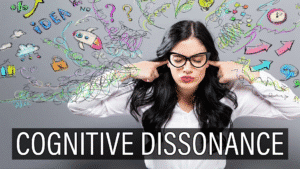
Half of our voting population is challenged with some form of
Cognitive Dissonance.
Cognitive dissonance is the psychological discomfort experienced when
a person holds two or more conflicting ideas, beliefs, or values, or
when their behavior contradicts their beliefs.
Cognitive dissonance often encourages a person to
change their perception of reality—
seeing things not as they truly are, but
in a way that reduces the mental conflict.
This change in perception often makes the dissonant
ideas, beliefs, or actions fit better with existing personal or political agendas, justifying their stance or behavior.

First proposed by psychologist Leon Festinger,
this mental stress motivates the individual to
reduce the inconsistency to restore inner balance.
People often resolve this by:
Changing their behavior (e.g., quitting smoking).
Changing their belief (e.g., deciding the evidence against smoking isn’t conclusive).
Rationalizing or justifying the conflict
(e.g., believing that smoking helps relieve stress, making it worth the health risk).
This drive to maintain consistency influences
decision-making, attitude changes, and behavior.
Cognitive dissonance in religion and politics.

Cognitive dissonance in religion and politics occurs when
an individual holds conflicting beliefs, values, or behaviors
related to these domains, causing mental discomfort that they seek to reduce.
⛪ Religion
Religious dissonance arises when core faith teachings clash with
personal actions, new scientific information, or contradictory doctrines.
Examples:
A religious person who believes in non-violence yet supports a war,
or
someone whose faith preaches charity but votes against policies that aid the poor.
Dissonance Reduction:
People may re-interpret scripture to align with their actions,
rationalize the contradiction (e.g., “God’s will is mysterious”),
or
avoid information that challenges their faith.

🏛️ Politics
Political dissonance often emerges when
a person’s affiliation or support for a party/leader
conflicts with their personal values or undeniable facts.
Examples:
A voter who champions honesty but
continues to support a pathological lying politician known for corruption,
or
a person who values environmental protection but
belongs to a party that consistently deregulates industry.
Dissonance Reduction:
Individuals may
downplay the severity of the conflicting information
(trivialization),
Selectively consume only news that confirms their existing views
(confirmation bias),
or
justify the inconsistency by arguing that
the party/leader is still the “lesser of two evils.”
In both areas,
the intense desire to maintain a consistent self-image and group identity
often leads people to reduce dissonance
by changing their perceptions or beliefs,
rather than changing their behavior or allegiance.

In order to of have ‘cognitive’ dissonance…
One must have the mental capacity to be evolved and intelligent enough to be…
Cognitive.
Anyone still supporting tRump is challenged with some form of
cognitive dissonance…
Or
They have just not evolved enough,
lack the mental capacity for critical thinking
or not intelligently evolved enough to be…
Cognitive.
Cognitive relates to cognition,
which encompasses all the mental processes involved in
gaining knowledge and comprehension.
This includes essential mental activities like
thinking, memory, attention, learning, perception, judgment,
reasoning, and problem-solving.
In essence,
“cognitive” is the adjective used to describe anything having to do with
how your brain processes information.
Analysts suggest Trump’s frequent falsehoods serve
political, psychological, and strategic purposes,
including riling up supporters, attacking opponents, boosting his image,
and maintaining power by creating his own narrative,
often repeating claims to gain acceptance.
Then why do his Believers believe a psychopathic liar?
His supporters prioritize loyalty and political goals over factual accuracy.
They may view his rhetoric as communicating a “deeper truth”
about their grievances,
or
psychological factors like confirmation bias, social identity, and
repeated exposure to claims reinforce their belief.
You’ll notice tRump often repeats his BS 3 times in a row…
This is classic military grade psyops to
psychologically brainwash the mentally vulnerable.

Demagogue politicians often proclaim wild unsubstantiated conspiracy theories
to help them take advantage of the mentally vulnerable.
Conspiracy theories are a flawed tool
meant to help make sense of a nonsensical world.
The truth is darker:
You don’t need an elaborate master plan to dodge moral and criminal accountability
when all his supporters are all too willing to simply look the other way.
If you are brave and patient enough to attempt to teach a pig to sing…
Then
Perhaps you might have what it takes to attempt to have
a rational conversation with a tRump supporter…
Note:
If they are still pretending to be a “Christian” that supports tRump’s pedophilia,
countless criminally corrupt behavior and his child-like mental process…
First try to teach a pig to sing! …

If you can get a pig to oink on time and in pitch…,
You might be ready
to have a rational conversation with an atheist tRump supporter.
A “Christian” that supports the antithesis of what their religion once stood for
along with the 10 commandments and the message of Jesus…
They’ve abandoned all they pretended to be sacred,
flushed it all down the toilet
and now embrace their new orange turd of a “messiah”…
don’t waist your time…
like teaching a pig to sing…
it will just waist your time and annoy the pig…
I know…
I have tried for over a decade now.
But,
If you feel like you are in the presents of someone that
might be mentally capable of at least listening to reason…
Here’s some advice in dealing with cognitive dissonance in others.

Non-confrontational communication focuses on “I” Statements
and active listening to express your needs without blaming.
1. Use “I” Statements
This technique shifts the focus from accusing them
(“You always…”) to explaining your own feelings and the resulting impact.
Format for relationships:
“I feel [emotion] when [specific behavior] because [impact on you].”
Example: Instead of “You never listen to me,” say:
“I feel unheard when you interrupt me because I can’t finish my thought.”
2. Practice Active Listening
Give your full attention and reflect back what they said to show you understand,
which lowers their defensiveness.
Techniques: Paraphrase (“What I hear you saying is…”),
validate their feelings
(“That makes sense; I can see why you feel that way”),
and ask clarifying, non-judgmental questions.
Transposing this to a political discussion regarding topics that s
should be common sense…
things like morality… raping underaged girls…
criminally corrupt… 34 felony convictions and 1000’s of legal actions.
seriously believing a psychopathic lier that is
arrested in psychological development as the pissed off petulant 5-year-old
and a sociopath that lacks the mental capabilities to give a shit about
the people he shits on everyday…
You will encounter every textbook responses with
spontaneous mindless reactions starting with:
Denial and Deflection…
Then prance about with the above-mentioned excuses
that were inspired by their own…
cognitive dissonance.

Demagogue politicians using military grade psyops

to take advantage of the mentally vulnerable
by manipulating their perspectives in order to gain
political and personal advantages…
All at the demise of our society and the human condition.
This dysfunctional and self-defeating mode of governing
is bringing about the fall of our society and country
in what is now likely to be…
Unrepairable.
Read the full article




